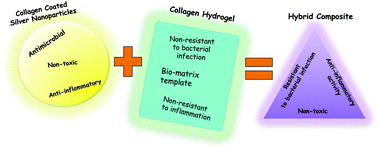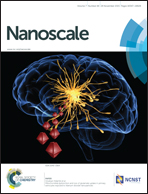Safety and efficacy of composite collagen–silver nanoparticle hydrogels as tissue engineering scaffolds†
Abstract
The increasing number of multidrug resistant bacteria has revitalized interest in seeking alternative sources for controlling bacterial infection. Silver nanoparticles (AgNPs), are amongst the most promising candidates due to their wide microbial spectrum of action. In this work, we report on the safety and efficacy of the incorporation of collagen coated AgNPs into collagen hydrogels for tissue engineering. The resulting hybrid materials at [AgNPs] < 0.4 μM retained the mechanical properties and biocompatibility for primary human skin fibroblasts and keratinocytes of collagen hydrogels; they also displayed remarkable anti-infective properties against S. aureus, S. epidermidis, E. coli and P. aeruginosa at considerably lower concentrations than silver nitrate. Further, subcutaneous implants of materials containing 0.2 μM AgNPs in mice showed a reduction in the levels of IL-6 and other inflammation markers (CCL24, sTNFR-2, and TIMP1). Finally, an analysis of silver contents in implanted mice showed that silver accumulation primarily occurred within the tissue surrounding the implant.


 Please wait while we load your content...
Please wait while we load your content...